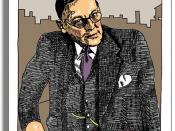T. S. Eliot's religious journey was a powerful one. While he struggled with religion in his early years, his later works show his deep understanding of the spiritual world. Written in the midst of his spiritual awakening, Eliot's "The Hollow Men" uses the metaphor of stone in conjunction with Biblical images to show the flawed nature of human goals in modern society, the consequences related, and the ultimate solution.
Part II of "The Hollow Men"ÃÂ discusses the speaker's fear of being seen by the "Eyes I dare not meet in dreams"ÃÂ (19). The question arises: Whose eyes are fearsome enough that he dares not to meet them? The poem also states that "There, the eyes are / Sunlight on a broken column"ÃÂ (22-23). In the Bible, sunlight is used as a symbol of God's presence. During Jesus' baptism "heaven was opened, and he saw the Spirit of God descending"ÃÂ (Matthew 3:16).
In the poem, sunlight is on the broken column, which leads us to wonder as to the symbolism of this pillar, and of the significance of stone in general. There are few things that are worthy enough to be perceptively watched by God. Human purpose and aspiration is one of them, and because this poem deals with a lack of spiritual purpose, this is a possible interpretation. This column stands broken, implying that humanity's goals are flawed.
In section III, "the stone images / Are raised, here they receive / The supplication Kleinschmidt - 2 of a dead man's hand"ÃÂ(41-43). The raising of the stone shows the failure of human goals. Thinking that their goals are solid, the hollow men raise them up and strive for them. The images, similar to the column, are broken, showing their lack of truth. This is a very...


